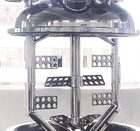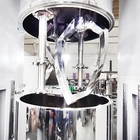Top 5 Mistakes to Avoid When Buying a Filling Machine: Operational and Capacity-Related Mistakes
There are many types of filling machines, each designed for specific products and production needs. At first glance, the variety can feel overwhelming. But once your needs are clearly defined, the decision becomes easier. Still, even with a good idea of what you want, it’s easy to overlook key factors that can impact your efficiency, costs, and future growth.
In this article, we’ll walk through the most common Operational and Capacity-Related Mistakes companies make when purchasing a filling machine. These points are explained in a simple, practical way to help you avoid costly errors down the line. If you need more specific guidance, feel free to reach out — we’re happy to help.
At this stage, the requirements are clear, the budget is reviewed, the vendor is selected, and the machine is chosen. Now comes one last crucial step before finalizing the purchase: making sure all Operational and Capacity-Related considerations have been addressed. We will walk you through the most common mistakes in that area — ones that are easy to overlook but can seriously affect your production down the line.
Underestimating Future Production Needs
It might seem logical to buy a machine based on your current production volume. But what happens if demand grows in 6 months and your machine can’t keep up? You could be forced to:
- Replace the machine early (expensive)
- Run extra shifts (inefficient)
- Delay or lose orders (reputation damage)
Filling machines are long-term investments, and buying one that’s “just enough for now” can quickly turn into a limitation. Consider future growth: Will you expand into new markets? Launch new variants? Increase volume?
Ask yourself:
- Can the machine handle a 20–30% production increase?
- Is it compatible with different bottle sizes or product types?
- Can it be upgraded or reconfigured later?
A little foresight now can save you major expenses and headaches in the near future.
Overlooking Downtime and Maintenance Needs
Many buyers focus on price, speed, or accuracy — and forget about how often the machine needs to stop. But downtime and maintenance play a major role in your long-term performance.
Let’s break this into two parts:
Overlooking Downtime
Downtime includes any moment the machine isn’t running — cleaning, setup, small stoppages. These interruptions add up fast:
- Frequent stops reduce your overall productivity
- Even short interruptions lead to hours of lost output over time
- In tight schedules, downtime can mean missed deadlines
- Inconsistent flow can create bottlenecks in the line
Overlooking Maintenance Needs
Some machines require frequent upkeep, part replacement, or deep cleaning. If this isn’t factored in when buying, you may end up with:
- Regular production interruptions
- Expensive or hard-to-source spare parts
- Need for specialized tools or trained technicians
- A drop in performance and product quality over time
Key questions to ask your supplier:
- How often does the machine need to stop during regular use?
- Are parts easily accessible during maintenance?
- Is cleaning quick and safe?
- Can your current team manage maintenance? Or will you need outside help?
- Are spare parts readily available?
Bottom line:
A low-maintenance machine might cost more upfront — but could save you far more over time in reduced downtime, labor, and lost production.
Ignoring Operator Skill Requirements
Buying a machine means introducing a new system into your workflow. Some machines are plug-and-play. Others are highly automated with complex settings and controls.
If you don’t consider the skill level required to operate it, you risk slowing down production or increasing errors.
- Training Time
Complex machines often require days of training before operators can use them confidently. A steep learning curve delays production start and increases onboarding time for new hires.
- Skilled Labor
You may need people who can:
- Calibrate precision settings
- Troubleshoot and resolve errors
- Perform technical adjustments
If you don’t already have that skillset in-house, you'll need to train or hire — both of which raise labor costs.
- Risk of Errors
Without proper training, operators may:
- Misconfigure settings
- Cause spills, underfills, or overfills
- Damage the machine
That leads to wasted product, inconsistent quality, and unplanned downtime.
- Reduced Efficiency
Even the fastest machine on paper won’t deliver results if your team struggles to use it.
Ask these questions before buying:
- How complex is the user interface?
- What kind of training is required?
- Does the supplier provide documentation or training support?
- Can your current team operate the machine effectively?
Tip: Involve your staff supervisor during the decision process to make sure the team is ready.
Ignoring Machine Speed vs. Production Line Speed
Let’s say you’re only buying a filling machine, but you’ll integrate it into an existing line — from mixing to filling to capping and labeling. You’ll need to match the filling machine’s speed with the rest of the line, usually measured in units per minute (UPM).
If the filler is slower than the rest of the line:
- Bottles pile up before the machine, requiring conveyor pauses
- The upstream (mixers, bottle feeders) must slow down
- The downstream (cappers, labelers) run out of filled bottles
- Result: Bottlenecks, idle workers, delays, and possible product degradation
If the filler is faster than the rest:
- The filler waits for bottles to arrive, causing start/stop cycles
- This adds wear and tear on mechanical parts
- Filled bottles may jam the conveyor or spill if downstream machines can’t keep up
- Result: Wasted product, reduced efficiency, and unnecessary stress on your system
|
Scenario |
Upstream Impact |
Filling Machine Impact |
Downstream Impact |
Risks & Consequences |
|
Filler is slower |
Containers pile up before the filler, requiring conveyor pauses or manual intervention |
Filler runs constantly but slows the whole production line |
Cappers, labellers, or packers wait for filled containers |
Bottlenecks, lost production time, worker idling, overheating, and potential product degradation |
|
Filler is faster |
Filler waits for containers to arrive; may sit idle frequently |
Wears out faster due to start/stop cycles |
Filled containers pile up after filling, causing jams or spills |
Overflow, mechanical strain, product loss, inefficient production rhythm |
Here are the Solution :
- Match your filling speed to your overall line capacity
- Choose machines with adjustable speeds or modular upgrades
- Always assess the entire line’s flow, not just the filler
Failing to Consider Integration with Existing Equipment
This one is especially relevant if you already have a production line or if you’re upgrading a single machine like the filler. A machine isn’t an isolated tool — it must integrate seamlessly with everything around it: conveyors, cappers, labelers, packaging systems, automation controls, and utilities.
Mechanical Mismatches
- Conveyor height or width doesn’t align
- Bottle guides or spacers don’t match
- Poor transitions between machines cause jams or spillage
Speed & Timing Conflicts
- One machine too fast = overflow or idle time
- One machine too slow = bottlenecks and delays
Control System Issues
Modern machines often use PLCs and smart sensors. If communication protocols aren’t aligned:
- Machines won’t sync start/stop signals
- You may need expensive reprogramming
- The line may need manual operation
Utility Incompatibility
Different machines may have different power or air requirements:
- Electrical mismatches (voltage, phase)
- Airflow or pressure issues
- Utility system overloads
Workflow & Layout Fit
Finally, does the new machine fit your actual workspace?
- Does it match your line direction (left-to-right, etc.)?
- Can operators access it easily and safely?
- Will you need to add tables, turning stations, or new rails?
Avoid surprises by checking:
- Conveyor dimensions
- Communication systems (PLCs, automation platforms)
- Power and air supply
- Full container flow simulation before buying
Conclusion: Take Your Time, Ask the Right Questions
This guide focused on filling machines, but the principles apply to almost any industrial equipment purchase. Every choice — from speed and layout to operator skill and maintenance — affects your long-term production.
Most of these mistakes are avoidable if you take the time to:
- Ask the right questions
- Talk to your team and technicians
- Involve your supplier in the full picture — not just the machine you’re buying
A smooth production process starts with smart buying decisions.














































































































